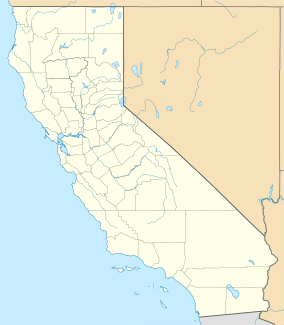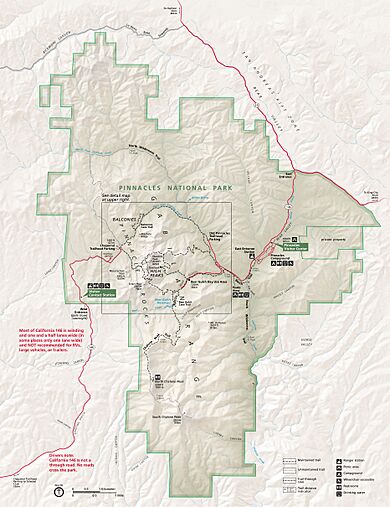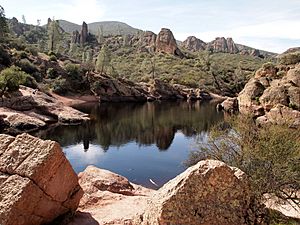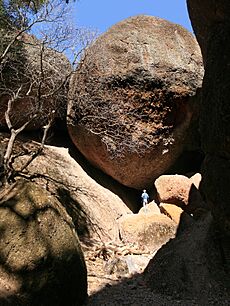Pinnacles National Park facts for kids
Quick facts for kids Pinnacles National Park |
|
|---|---|
|
IUCN Category II (National Park)
|
|
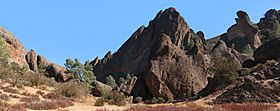
Rock formations at Pinnacles National Park
|
|
| Location | San Benito County & Monterey County, California, United States |
| Nearest city | Soledad, California |
| Area | 26,606 acres (107.67 km2) |
| Established | January 16, 1908 as a national monument January 10, 2013 as a national park |
| Visitors | 275,023 (in 2022) |
| Governing body | National Park Service |
Pinnacles National Park is a special place in Central California. It protects a beautiful mountainous area east of the Salinas Valley. The park is about 5 miles (8 km) east of Soledad and 80 miles (129 km) southeast of San Jose.
The park gets its name from its amazing rock formations. These rocks are what's left of the western part of an old volcano. This volcano moved 200 miles (322 km) from its original spot because of the San Andreas Fault. The National Park Service manages Pinnacles, and most of it is a protected wilderness area.
Pinnacles National Park is split into East and West sides by the rock formations. You can only connect between them by walking trails. The east side has more shade and water. The west side has tall rock walls. These cool rock formations are great for rock climbers. The park also has unusual talus caves, which are home to at least 13 types of bats.
People usually visit Pinnacles in spring or fall. This is because summer can be very hot. The park is a perfect home for prairie falcons. It's also a release site for California condors that were born in captivity.
Pinnacles started as a national monument in 1908. President Theodore Roosevelt created it. Later, in 2013, it became a national park.
Contents
History of Pinnacles
Long ago, Native Americans lived in the Pinnacles area. They were from the Chalon and Mutsun groups of the Ohlone people. They left behind stone tools in the park. When the Spanish arrived in the 1700s, many native people got sick or had to leave. A Spanish mission in Soledad also caused the native population to shrink.
Archaeologists have found 13 places where Native Americans lived. Twelve of these places were used before the missions were built. One site might be about 2000 years old. By 1810, the last Chalon people had left the area. From 1810 to 1865, the Pinnacles region was wild and empty of people.
Early Visitors and Protection Efforts
By the 1880s, people from nearby towns visited the Pinnacles. They called them the "Palisades" back then. They would have picnics, explore the caves, and camp. The first newspaper story about the Pinnacles appeared in 1881.
Interest in the area grew. People even thought about building a resort hotel there, but it didn't happen. In 1894, a post office opened in Bear Valley. It was named "Cook" after the postmaster's wife. In 1924, it was renamed "Pinnacles."
Schuyler Hain was a homesteader who moved to the Pinnacles area in 1891. He loved the Pinnacles and wanted to protect them. He gave tours and told everyone how special the area was. His efforts led to President Theodore Roosevelt creating the Pinnacles Forest Reserve in 1906.
Then, on January 16, 1908, President Roosevelt used the Antiquities Act to make the most beautiful part of the area a national monument. This helped protect the Pinnacles even more.
Becoming a National Monument
Pinnacles was first protected as a forest reserve in 1906. In 1908, President Theodore Roosevelt made it a national monument. This meant it was a special place protected by the government. The monument started with about 2,080 acres (842 hectares).
At first, there wasn't a specific agency to manage it. Local people wanted better roads to the monument. By 1914, some basic roads reached Bear Valley.
The National Park Service was created in 1916. But Pinnacles wasn't seen as important enough for their help yet. Over time, local people kept asking the Park Service to take over. In 1923, Herman Hermansen became the caretaker. On May 7, 1923, President Warren G. Harding made the monument bigger.
In 1924, President Calvin Coolidge made the monument even larger. This helped protect water sources and camping spots. Money was set aside to build a ranger's cabin, which was finished in 1929. The caves were also improved for visitors.
In the 1930s, the Civilian Conservation Corps (CCC) helped a lot. About 200 men worked on building more trails. They also improved the road in Bear Gulch and built tourist cabins. The CCC even built a dam for the Bear Gulch reservoir.
The park's visitor center and headquarters were built in 1936–37 using local stone. Over the years, the monument grew in size. By 1975, it was 16,721 acres (6,767 hectares). Today, it is 26,606 acres (10,767 hectares).
Becoming a National Park
In 2013, Pinnacles National Monument became a national park. This happened when President Barack Obama signed a new law on January 10, 2013. The law also named the wilderness area inside the park the Hain Wilderness. This was to honor Schuyler Hain, who worked hard to protect the Pinnacles.
Becoming a national park didn't change how the park was managed. All units of the National Park System are treated equally. Pinnacles is the ninth national park in California.
Geography
Pinnacles National Park is about 40 miles (64 km) from the Pacific Ocean. It's also about 45 miles (72 km) south of the San Francisco Bay Area. The park is in the southern part of the Gabilan Range. This range is part of California's Coast Ranges.
The land inside the park ranges from 824 feet (251 meters) to 3,304 feet (1,007 meters) high. North Chalone Peak is the highest point.
Climate
Pinnacles National Park has a hot-summer Mediterranean climate. This means it has hot, dry summers and mild, wet winters. The Santa Lucia Mountains are between the park and the ocean. They block the ocean's cooling effect. So, temperatures in the park can change a lot between day and night. This change can be 30 to 50 degrees Fahrenheit (17 to 28 degrees Celsius).
The park usually gets about 17 inches (432 mm) of rain each year. Sometimes, a small amount of snow can fall on the higher peaks in winter.
| Climate data for Pinnacles National Monument, California (1991–2020 normals, extremes 1937–present) | |||||||||||||
|---|---|---|---|---|---|---|---|---|---|---|---|---|---|
| Month | Jan | Feb | Mar | Apr | May | Jun | Jul | Aug | Sep | Oct | Nov | Dec | Year |
| Record high °F (°C) | 87 (31) |
86 (30) |
93 (34) |
100 (38) |
106 (41) |
112 (44) |
116 (47) |
115 (46) |
116 (47) |
116 (47) |
94 (34) |
90 (32) |
116 (47) |
| Mean maximum °F (°C) | 75.9 (24.4) |
77.6 (25.3) |
82.4 (28.0) |
89.8 (32.1) |
95.9 (35.5) |
103.9 (39.9) |
106.5 (41.4) |
107.1 (41.7) |
104.7 (40.4) |
97.9 (36.6) |
86.7 (30.4) |
75.0 (23.9) |
109.5 (43.1) |
| Mean daily maximum °F (°C) | 62.6 (17.0) |
63.7 (17.6) |
67.5 (19.7) |
72.3 (22.4) |
80.0 (26.7) |
88.8 (31.6) |
95.9 (35.5) |
95.8 (35.4) |
91.7 (33.2) |
82.5 (28.1) |
70.4 (21.3) |
62.0 (16.7) |
77.8 (25.4) |
| Daily mean °F (°C) | 48.3 (9.1) |
49.6 (9.8) |
52.6 (11.4) |
55.8 (13.2) |
61.5 (16.4) |
67.7 (19.8) |
73.2 (22.9) |
73.0 (22.8) |
69.9 (21.1) |
62.6 (17.0) |
53.5 (11.9) |
47.7 (8.7) |
59.6 (15.3) |
| Mean daily minimum °F (°C) | 34.0 (1.1) |
35.6 (2.0) |
37.7 (3.2) |
39.4 (4.1) |
43.1 (6.2) |
46.6 (8.1) |
50.4 (10.2) |
50.3 (10.2) |
48.1 (8.9) |
42.7 (5.9) |
36.7 (2.6) |
33.4 (0.8) |
41.5 (5.3) |
| Mean minimum °F (°C) | 23.2 (−4.9) |
25.1 (−3.8) |
27.6 (−2.4) |
29.7 (−1.3) |
33.1 (0.6) |
35.9 (2.2) |
39.0 (3.9) |
39.8 (4.3) |
37.9 (3.3) |
32.2 (0.1) |
26.1 (−3.3) |
22.3 (−5.4) |
19.8 (−6.8) |
| Record low °F (°C) | 10 (−12) |
17 (−8) |
16 (−9) |
18 (−8) |
22 (−6) |
24 (−4) |
30 (−1) |
28 (−2) |
29 (−2) |
24 (−4) |
15 (−9) |
10 (−12) |
10 (−12) |
| Average precipitation inches (mm) | 3.46 (88) |
3.45 (88) |
2.80 (71) |
0.96 (24) |
0.57 (14) |
0.13 (3.3) |
0.04 (1.0) |
0.02 (0.51) |
0.06 (1.5) |
0.73 (19) |
1.27 (32) |
3.08 (78) |
16.57 (421) |
| Average snowfall inches (cm) | 0.1 (0.25) |
0.0 (0.0) |
0.0 (0.0) |
0.0 (0.0) |
0.0 (0.0) |
0.0 (0.0) |
0.0 (0.0) |
0.0 (0.0) |
0.0 (0.0) |
0.0 (0.0) |
0.0 (0.0) |
0.0 (0.0) |
0.1 (0.25) |
| Average precipitation days (≥ 0.01 in) | 12.2 | 11.2 | 10.1 | 5.7 | 3.3 | 0.7 | 0.3 | 0.3 | 0.6 | 2.9 | 7.2 | 12.0 | 66.5 |
| Average snowy days (≥ 0.1 in) | 0.1 | 0.0 | 0.0 | 0.0 | 0.0 | 0.0 | 0.0 | 0.0 | 0.0 | 0.0 | 0.0 | 0.0 | 0.1 |
| Source: NOAA | |||||||||||||
Geology: How Pinnacles Formed
Pinnacles National Park is close to the San Andreas fault. This famous fault helped create the park's unique rock formations. The Pinnacles rocks are actually part of a volcano called the Neenach Volcano. This volcano erupted 23 million years ago near a place called Lancaster today.
Over millions of years, the Pacific Plate moved along the San Andreas fault. This movement broke off a piece of the volcano and moved it 195 miles (314 km) to the northwest. Scientists know these rocks came from that volcano because they have special rock types found only there. Wind and water slowly wore away the rocks, forming the tall pinnacles we see now.
Talus Caves and Faults
Huge earth movements also created the talus caves in the park. These caves formed when big rocks fell into narrow canyons. They got stuck, creating open spaces and tunnels below.
The San Andreas fault has moved about 4 miles (6 km) east of the park since the Pinnacles arrived here. You can still see where the original San Andreas fault was in the Chalone Creek fault. There are two other large faults in the park, the Miner's Gulch and Pinnacles faults. These faults run parallel to the San Andreas fault.
The park often has small earthquakes. The United States Geological Survey has two earthquake sensors here. You can see signs of past earthquakes in streams that have shifted where they cross faults.
Ecology: Plants and Animals
Wildlife in Pinnacles
Many native animals live in Pinnacles National Park. Some animals like tule elk and pronghorn used to live here but are now gone from most of central California. Grizzly and black bears were also here until the late 1800s.
Today, you might see animals like prairie falcons, coyotes, skunks, great horned owls, bobcats, California quail, raccoons, wild turkeys, gray foxes, golden eagles, and cougars.
Pinnacles is home to many prairie falcons. They nest here in some of the highest numbers in North America. Peregrine falcons have also started nesting in the park again. Since 2003, there's been a program to bring back the California condors. The first condor nest in the wild since the program started was found in 2010. Now, about 25 free-flying condors live in the park.
Thirteen types of bats have been found in Pinnacles. The talus caves are important places for bats to rest and raise their young.
In the 1990s, a student studied bees in Pinnacles. She found that the park has more bee species per area than almost anywhere else on Earth! There are about 400 different kinds of bees. Most of these are solitary bees, meaning they don't live in big colonies like honeybees. They usually live for only a few weeks. Because different flowers bloom all year, there's always food for many bee species.
Like many parks in California, Pinnacles used to have a problem with wild pigs. These pigs are a mix of escaped farm pigs and wild boars. They would dig up the land and cause damage. By 2006, the main part of the park was pig-free. This was thanks to a 20-year effort that cost $1.6 million. Park staff built a 26-mile (42 km) fence around the park's center. They still check the fence to make sure the pigs don't return.
Vegetation: Plants of Pinnacles
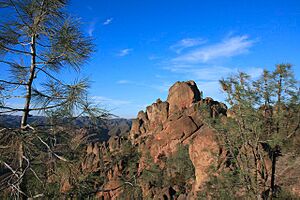
Most of the plants in Pinnacles National Park are chaparral. This is a type of shrubland common in California. There are also woodlands, areas along streams (riparian), and grasslands mixed in.
In the warmer parts of the park, you'll see large areas covered in greasewood. Other plants include manzanita, gray pine, canyon live oak, and blue oak. In cooler areas, there are more pines and oaks. You might also find California buckeye, hollyleaf cherry, and coffeeberry. Along streams, you'll see willows and elderberries.
Fire has always been important for the plants here. Natural fires happen, and Native Americans also used fire. They would burn areas to help certain food plants grow and to hunt small animals. Since native people left, the hills have become much bushier.
Hain Wilderness
More than 80% of Pinnacles National Park is a special protected area called the Hain Wilderness. This wilderness covers 15,985 acres (6,469 hectares). Wilderness areas have the highest level of protection. This means the rock spires, South Chalone Peak, and the creeks and canyons are kept wild. The creeks and canyons are home to the endangered California red-legged frog. The United States Congress made Pinnacles a wilderness area in 1976.
Activities at Pinnacles
The park has roads that lead to it from the west (near Soledad) and the east (south of Hollister). But these roads don't connect inside the park. Most of the visitor facilities are on the east side.
There are many trails for day hikers, and some are quite challenging. In March and April, you can see a huge variety of wildflowers. The trails offer great views of the hills and valleys on clear days. You can even see the San Andreas Fault from some spots. One famous hiking trail is called "The Pig Fence." It's a tough part of the South Wilderness Trail. Sometimes, you even need to use the fence (built to keep wild pigs out) to help you climb the steep path! Other trails are flatter, follow stream beds, or lead to high viewpoints.
The caves at Pinnacles are talus caves. They formed when big rocks fell into narrow canyons, creating tunnels. Bear Gulch Cave on the east side and Balconies Cave on the west side are open to visitors at certain times. Trails go into and through both caves. These caves are home to Townsend's big-eared bats. They are closed during the bat's pupping (baby-raising) season. The caves can also flood when there's a lot of rain. The National Park Service website tells you if the caves are open.
You can go camping at the Pinnacles Campground on the east side of the park.
The park is also popular with experienced rock climbers. There are many difficult climbs here. The rocks are volcanic, so climbers need to be careful because pieces can sometimes break off.
See also
 In Spanish: Parque nacional Pinnacles para niños
In Spanish: Parque nacional Pinnacles para niños


